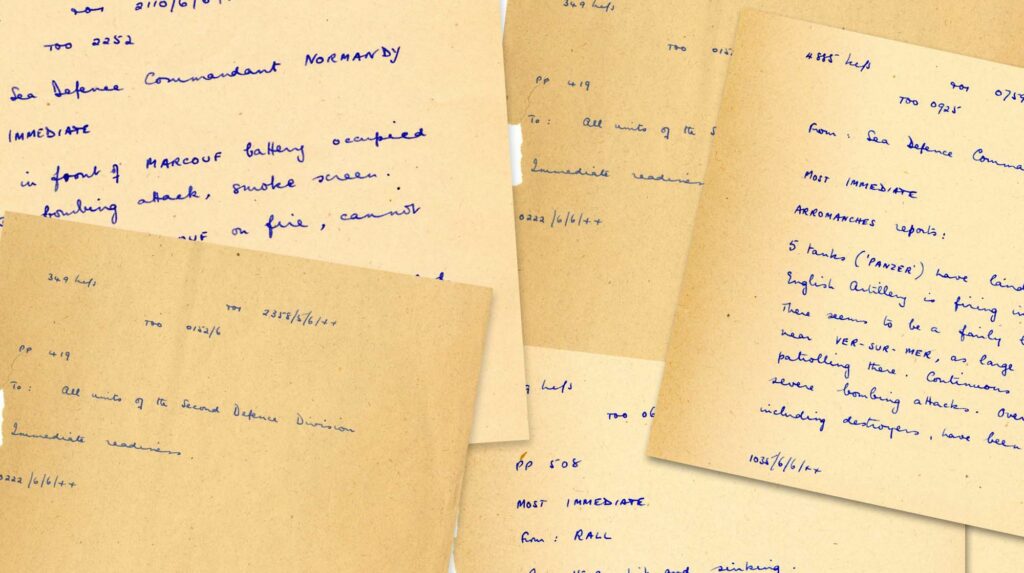Japan used many encryption systems during the course of World War Two, including numerical ciphers, such as the Japanese Navy’s General Operational Code (JN25). Bletchley Park’s codebreakers used statistical methods to decrypt numerical ciphers but even the decrypted messages were difficult to read. They were full of codenames and abbreviations. Tools such as this list of abbreviations commonly used by the Japanese Navy helped translators make sense of the message content.
XbTlngpeUZkpL3OVPHcyQke7oyhmbbEh2dLQmDRENXBFj6T5WvLRcuzPzWKsAcWVBDEcS0jROKaqEIRvQ6eVLokBBKFGAOBHKLmp9
r17vezEuQIn59wGRY8RXXXF0wQNAT9rvIbznZZ7D0jdv9AmVle46YAMlyYdD061s1n5MfZ5oYy7vWfA0SXrn0bXlSNy7j2zTHMkG6
b1zVTfB4dyxtCxPGlQZhcd0xFOWz8SOVP3F7upj2O7TAcYfkgoehYLNcSd4UvJAP7C2PjNL6ELILe0uBjITIOw2NpgWAii8Qcx2wT
hJSomSW0IUDA2qAUaoFeCZu0gDjOkhRUUgWCUnXN8PCDsQEofX9ZA6a5M3DCrWNFQyT0xRjnf7IdQ0dzTaqLbbujo2LtQZTWZxt3o
w1rX5Myfdv768YpwX7n2l61XZ5sAliWoJ7zNyNU7d4t1ELjVTupIAOmEbpVgAdEVSAuWxFwrF704aSvCWbrltrKjfgam5Kp7oSaqk
YUaIHw64TDN5JhBwIq4CBSWfd1cRunRGm61CQQEQW9HeTppCX5dslotVlXuxcA11oC6CKoFyejknvN8tpBa7ana86Bn42NTlgQXcs
NyICzGcpPdWpIUWQf21Hp8v88genJGVU3DPT8YGFwf15gK0MKO7OVLqvYrLjczW1bPVcDYyfVzXMziNlQkGuWdcQzTukJs1UL0OZ8
PGTlCnXBlYRg0eHKrWQ81KMMXd2TUYeLy254q3huohlqOfgEC4ANCKnTv4HVHiC7DT4Hbphenu72yL8KX6gLdGVmKSQJEux6m3k0T
8pxcZbqEF7tuA0L8vqqgm2fpLuSQIcbtM3QdUqJ0sJ3nhhEkYgOoD2EFJuuiwMfBgiNdAZY4UXc48MZW0DVNMOtGEC76HoWiDOgML
Aae22cLUVvMVb93gQd6deYnTdYO7ViEH8wjvCtU3RQpcIa9CchYBhZ4ztFdTVDUSre6s51nkA7SiiTzAcyLlljV2ixRGraRR5PHMf
2k2wSqhowKbij31mOh33Fe5M135CCWu6uGJUprciYHb5yYT34AMls0LU23grG5MdiQbuGiAmeDjnpHjuutQetX5QkHsFmLOMDFtpm
DdT2P8QjaAf9jO2MruSA4QPTcDJPuan7aKYdJtdnxHgiap3FzQDkRNPYByqNHpwi2pqqw1oXQYa0igzQMBWzbMWZOKM4wdZ3FVLnc
PqQuJbMoq0KUFnYSXjRI9po4AjNwfyctmAiCAWWLi8k6OIuT8QlBjgmveJ5UaPwahLj16kKdVcmwioBzq5734JObRwY7vNzPKbXN4
rcf3WaUoXWghvl68iPcXtqdQsZTG2r2Uddzi07iiamhKv69IQnh4WhAoNrCAYoNTf8b7e2dE3XVhmBeLgFzypjPgLsEkU9twwCGql
tCk9Rxos1Gl24XmXzUtMZIiG7XZz1w5EmHMk9nwblGxy97obbt1Y5ZCTtOLOXeiVlFZeIP1cr2KAmtiFVSDmtjhvMqWyYGoR1w9E4
ErRszvzeHqERiyi32flCMHA77R5QOJOR1X64sx9OQOAqPmeAkUz5kqGE1Bp9aHDgpnbM0apEMRy1zehVoCZJNI5vOeB8fXHTHS4bE
XWD0YHoW3os9zOQYfbJBUKUqewm9gpHFdsPj87VCGH6BKJ5ZR14DAIUFLEXN2TQPWTE3dhleuofWTg72UpgqrmiA4AOC99vxhHHZA
aEXV4lHyhW9ODsvGe6fXFbuHdG8ufHFbJhbsVkWAaypANoKIdCa8pt0RD2vImkpmJkm1JBmtUCGe1yyvL4LARWUP15RfpntUp07WU
xiT7VXtaiYFrPG5GexbusRd1Nn49moTieJ1ZFmEDCxg4KCRipggXTwnsSFgZwIdNet3wlZZwsLYhABwG3wuKclhNRtIzsMiCBcTPm
a0Fq0tVpjnQS4XkiNAfxXUGENHFQPtTf7qty5JddtV8Nqay85L17qt0TnF0bmEv8geK09ySCPRo2gE9otdWhHATUMiiYNHNtJLAiE
2CYGwv8gVkxsZV6dWGfrgx9j0vMK6CjGryozpAXrorB8lmT0goMALy1u2LaPomowv3iiS2IhWrmrieKSg5fmEcSOsNhLVrlrQAfEN
Kyywpg6qmdJKELUA4O6RDaXyusnddrIkh4hv1JXbTT9mK20iYccA8FRt7yWX2KJrBASBK86VMRVUW88bKKSyIDkzvuv9rl3LptGke
rylWHrZ7wYUNqLOW8UtcvAjS2dkX0O9eZvXTRM5ONe4hlfycON60vIxOjULUHqKSDW75j8C0W4y9ffOBgIkC5tebAYTDLbqNGp1pz
qPRPYg6em7DpDkHPIxfEQJSfoKjX7HtKnXIb7zuDMOJHjw6oyWCGrmOxaTvaHxorcY4PyqYcbB3QN5MjQoWlRsMDN5CI3dcfCrWcE
FTAEjzVEwiMOaRiiPquXeqSwjQ3vy5WHmMuP0dRr0QZKU4AR0yDE3je1IK54HmYnigNIMsCyUAl8xlQ8LtTQpMkUAje8kygEFAKwi
Xxc5nek4eYafP0zGkbmCzTsVuD3VHdArFjrJLNYVKgnfLW2ckZwGiaoy4S6NhWw33wRVgnmgEiiKFtiefCS4AImriUme6PbUiDjFm
XboxngpeUZkpL3OVPHcyQke7oyhmbbEh2dLQmDRENXBFj6T5WvLRcuzPzWKscWVBDEcS0jROKaqEIRvQ6eVLAokBBKFGAOBHKLmp9
ErPIisLYgRJ8IR2u7QOMxGNi6k6hs9tOWth3OM6TC0rOTQfvpz6IIzVTXBEQomQl1kWVcPwTqv2gdmTa6dC9x2PaS4qmqS5txyXer
SnYSsxGG6oebPBiGg5X0tMEsypWRYNu7bxfBvixZfRpFCBKnHSwtYb0vecLKHnvCC1OJsUOy5Skrf5XDzVYMdcCMxBhOxsv3iB5jR
XWD0YHoW3os9zOQYfbJBUKUqewm9gpHFdsPjibNYXDtFnO59Mur84fTkoy0IiYCdTE3dhleuofWTg72UpgqrmiAL4AOC99vxhHHZA
QOlal5GQaui90qp0Xm63jXnKGXbnDaeVuWh6SeNbh6Z52AL8wRmNrLKV9hlUYrPNK8QEmYDUciLoTkill6CPCbvtE5zdlRo1iQPS9
r17vezEuQIn59wGRY8RXXXF0wQNAT9rvIbznZZ7D0jdv9AmVle46YAMlyYdD01s1n5MfZ5oYy7vWfA0SXrn0bXlSNAy7j2zTHMkG6
1zVTfB4dyxtCxPGlQZhcd0xFOWz8SOVP3F7upj2O7TAcYfkgoehYLNcSd4UvJP7C2PjNL6ELILe0uBjITIOw2NpgWAWii8Qcx2wTA
VJ Day
The impact of Bletchley Park’s Japanese codebreaking operation on World War Two was just as significant as their work on German ciphers. In close cooperation with the Americans, thousands of codebreakers at Bletchley Park and outposts in India and across the Indian Ocean targeted Japanese naval, military and diplomatic signals. Efforts intensified in the latter years of WW2 and particularly after VE Day, when many staff who had been working on German ciphers were retrained for Japanese codebreaking. The intelligence gained through this US / UK partnership turned the tide of the war in the Pacific, paving the way to Japan’s surrender.
This album was first published on 15 August 2020 on what was the 75th anniversary of Victory over Japan (VJ) Day.
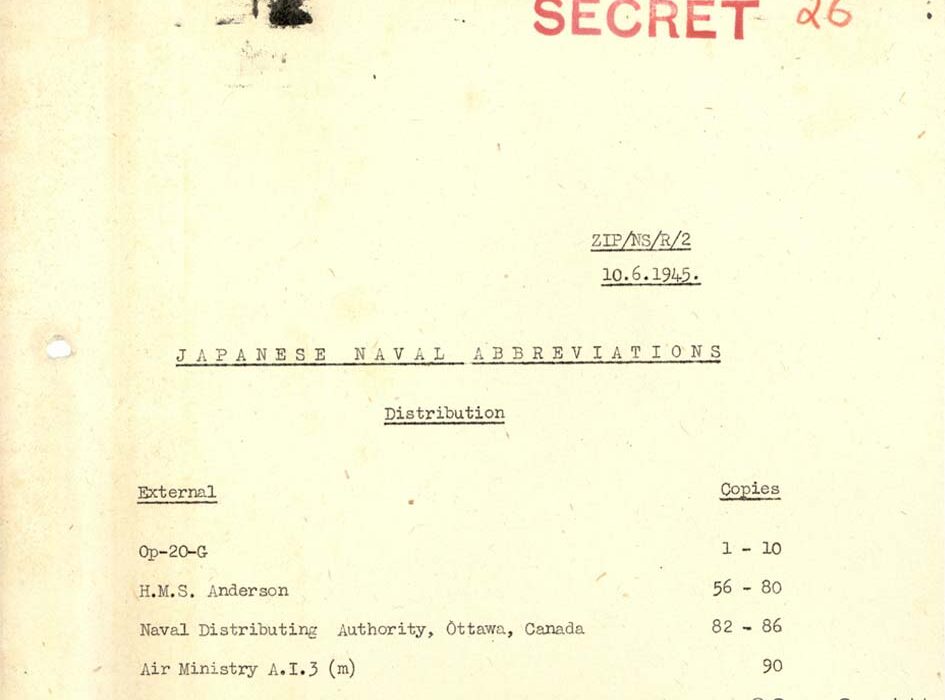
This is one of a series of flashcards used in Japanese language training. A working knowledge of Japanese was essential for translating Japanese messages, but Japanese speakers were in short supply. Captain Oswald Tuck, a retired Naval captain who had lived in Japan, was tasked with setting up a condensed language course that could equip Bletchley Park staff with a sufficient working knowledge of Japanese in as short a time as possible. The eleven-week course Tuck devised was so successful that it ran throughout the war. Graduates of Tuck’s Bedford Japanese School went on to work as translators at Bletchley Park, in East Asia, Australia and the USA.
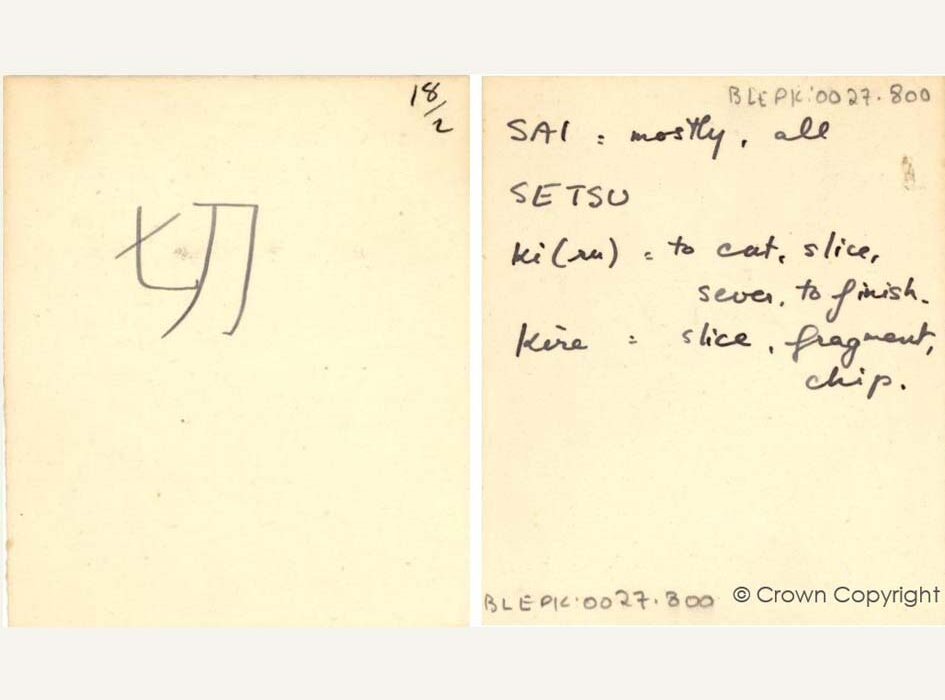
LAC Jack Kinsey was a wireless intercept operator against Japanese traffic at the Wireless Experimental Centre (WEC), on the outskirts of Delhi. The WEC was one of a number of overseas outposts of Bletchley Park. It was the main British operation for intercepting Japanese military codes and ciphers in WW2, covering wireless interception, traffic analysis and direction finding, codebreaking, and intelligence collation and reporting. This snapshot of Kinsey and his colleagues is from his wartime photograph album, recently donated to Bletchley Park.
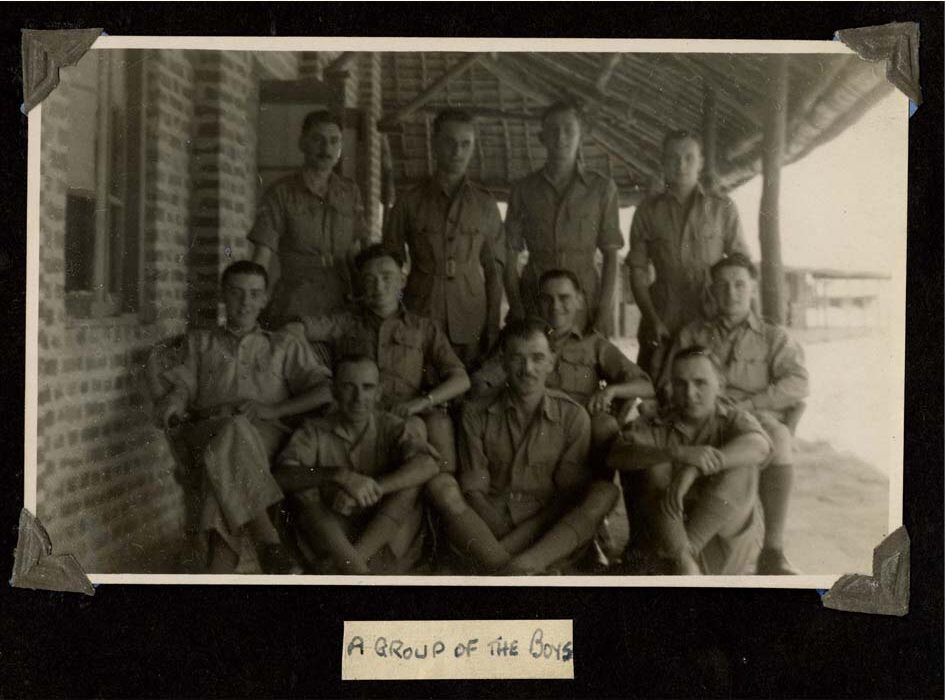
Also working as a wireless intercept officer was Wren Susan Fellowes (nee Broadhurst-Hill). She left England on 16 December 1943, bound for Colombo, in Ceylon (now Sri Lanka). The photograph shows her accommodation while working at the Far East Combined Bureau, another of Bletchley Park’s overseas signals intelligence centres, taking down Japanese Naval signals:
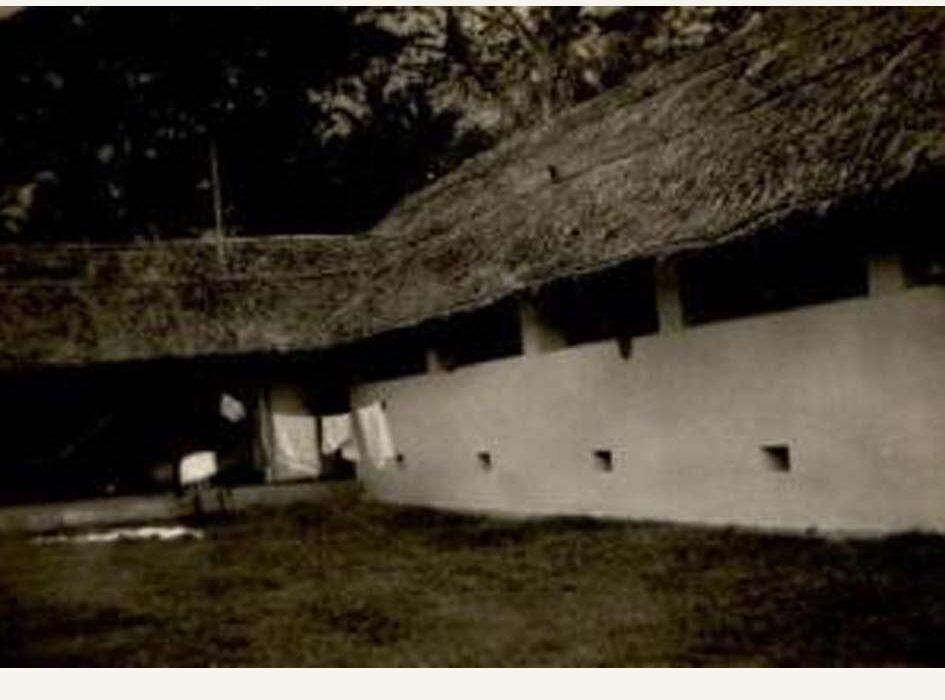
This excerpt is from a series of Far Eastern Summary Reports that collate Ultra intelligence gained from intercepted Japanese messages. Summary number 8 includes information on Japan’s monthly production of aircraft, the reopening of bombed railway bridges in Hanoi, Japanese order of battle, and instructions from the Southern Army in Manila to forces in New Guinea to discontinue the use of “special smoke shells, self-exploding bottles and similar weapons” so as not to provoke a chemical attack from the enemy.
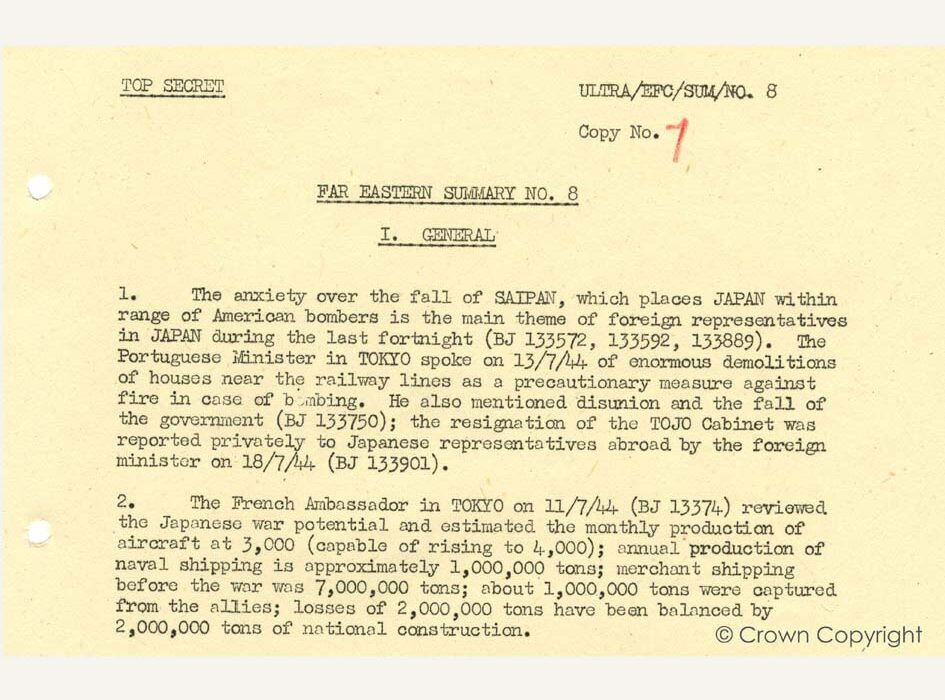
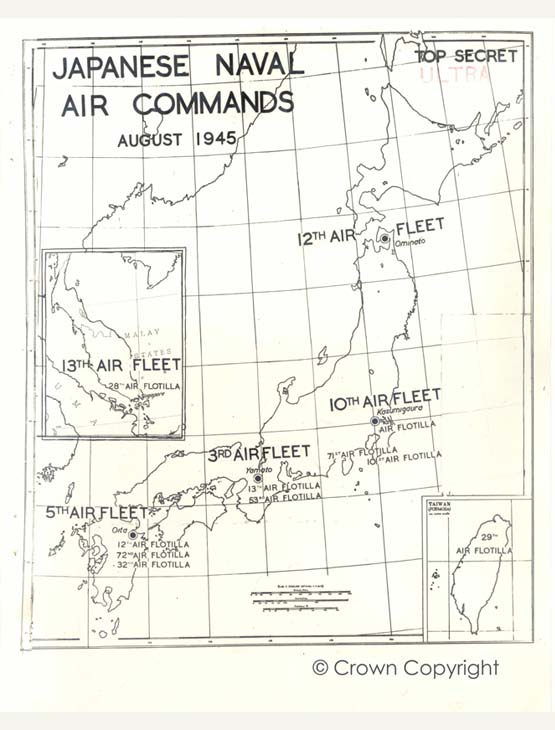
By the end of the war, the Allies had amassed a wealth of detailed intelligence about Japanese forces. This map, showing the locations of Japanese Naval Air Commands in August 1945, is taken from a report stamped ‘Top Secret Ultra’. Compiled on 20 September 1945, the report lists the “Organization, locations of command headquarters and subordination of units of the Japanese Army & Navy Air Forces”, based on information gathered up to August 1945.
In a typescript memoir, Hugh Norris, a Japanese translator in Naval Section at Bletchley Park, recalls hearing of the atom bombs dropped on Hiroshima and Nagasaki. He goes on to reflect on the abrupt cessation of work at Bletchley Park following VJ Day. “In retrospect, Bletchley did not seem to us at the time to be at all strange, once we had experienced a few weeks of initiation; it very soon became part of our lives; it was normality itself, and it seemed as if it was set to go on for ever. What was unnerving was when everything stopped so abruptly: it was the world outside, to which we now had to adapt, that was strange and foreign.”
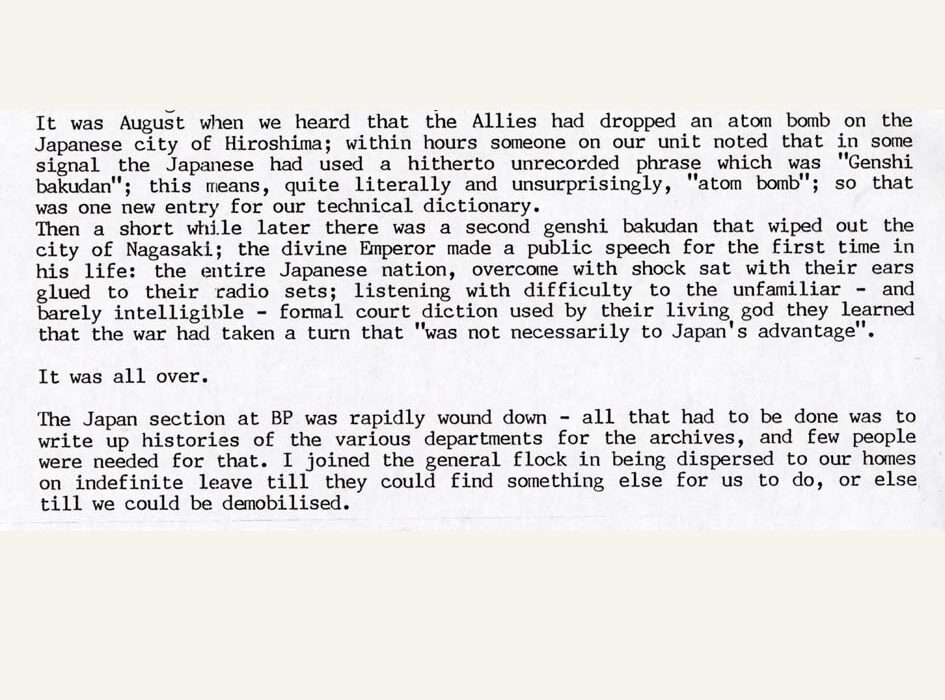
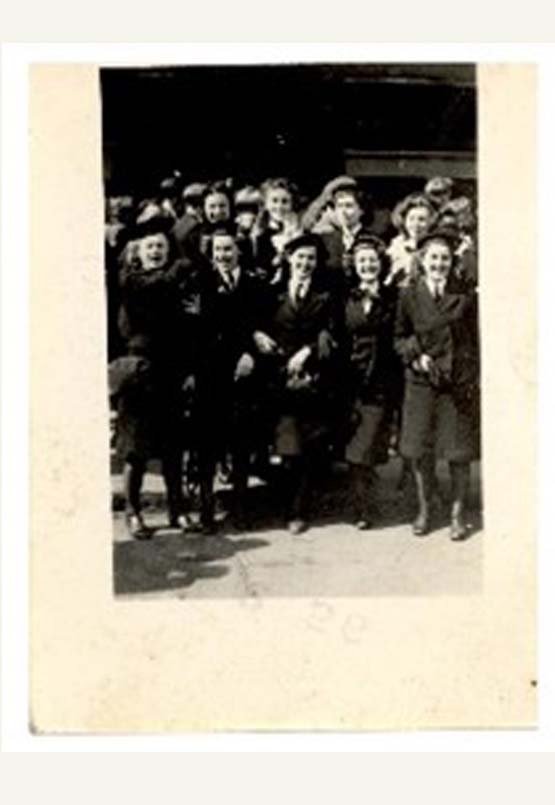
Veteran Joan Smeaton, née Addison, travelled to London to celebrate VJ Day with her fellow Wrens. After VE Day, she had been sent to retrain in Japanese Morse code. Joan was then posted to Flowerdown, a Royal Navy intercept station near Winchester, to work as an intercept operator for Japanese messages. “We were there when the War ended and we hitched up to London for the celebrations. We just stood at the side of the road in smart uniform and waited for a lift. You were never alone of course, usually in groups of two or three. I recall once that friends of ours had managed to get a lift in a lorry and there was me and my friend Sheila left on the roadside when a long sleek limousine drew up with two American Naval Officers in the back. They were going up to London and gave us a lift. We passed our friends in the lorry on the way!”
Veteran John Statham of Bletchley Park’s Naval Section recalls the codebreaking operations being wound up after VJ Day: “I was at Bletchley until it was finally closed … I remember things going up in smoke and the huts being trashed really. Well I say trashed, everything being torn up. It was such a sad time somehow. We were chucking stuff on bonfires and things like that. I remember “freeing” a typewriter from one of the Huts because all of the typewriters and the equipment were being chucked away. I freed this great big hefty thing which I kept for about a year but it was too hefty to go around. But if I hadn’t freed it, it would have gone on a bonfire or something.”
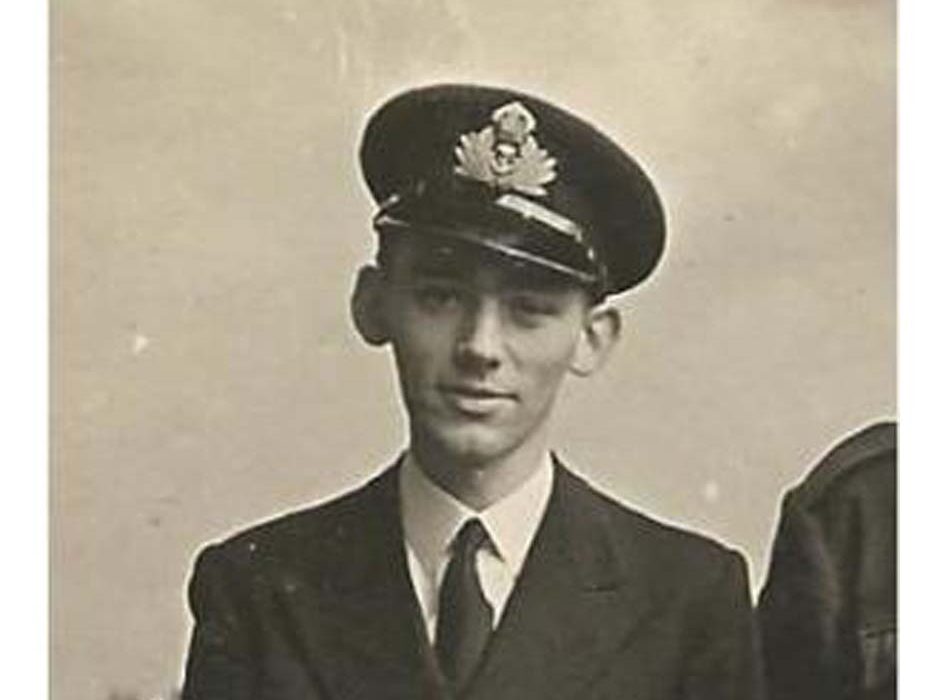
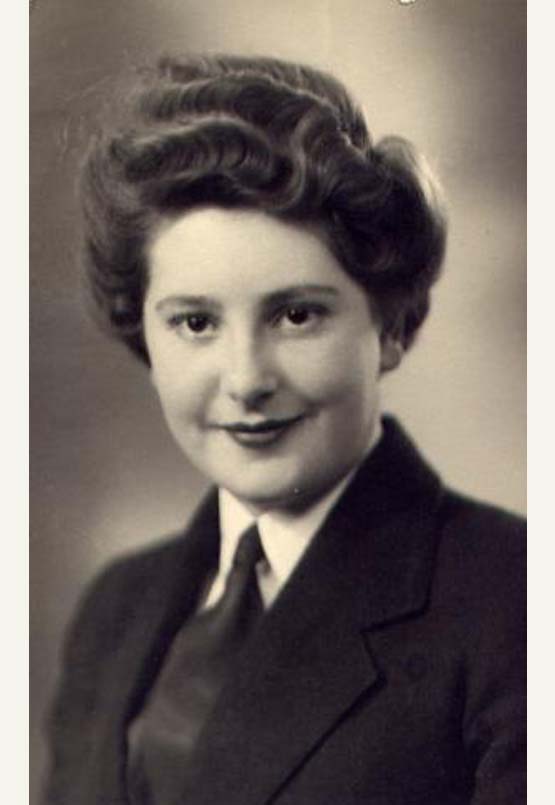
Wrens at the Far East Combined Bureau in Colombo, Sri Lanka, like Dot Tuffin (née Wilkinson), who had been working on Japanese codebreaking, were asked to volunteer to stay on after VJ Day to help acclimatise returning prisoners of war. “This was an entirely different aspect to our work, we just volunteered; the men looked pretty dreadful and we just wanted to help these men. It was harrowing for us; my friend and I cried ourselves to sleep every night – we couldn’t believe they could even walk, they looked so awful. The men came through in three to 4 weeks; we were told we had done our jobs, thank you very much, and we had to go back to Woburn Abbey to be demobbed.”
